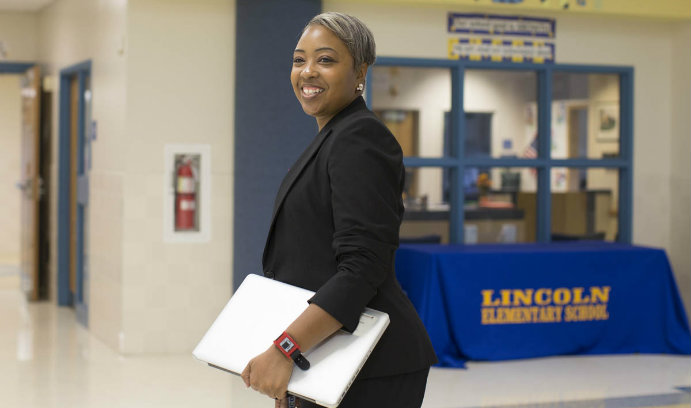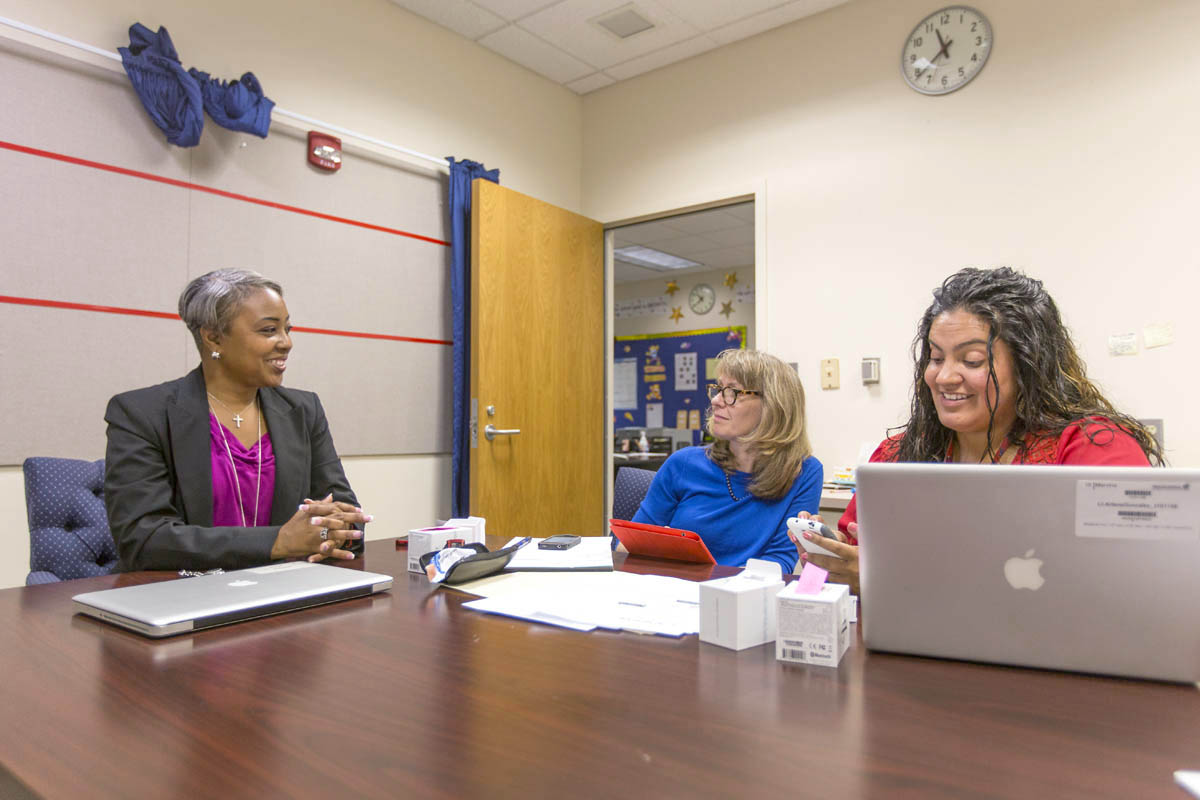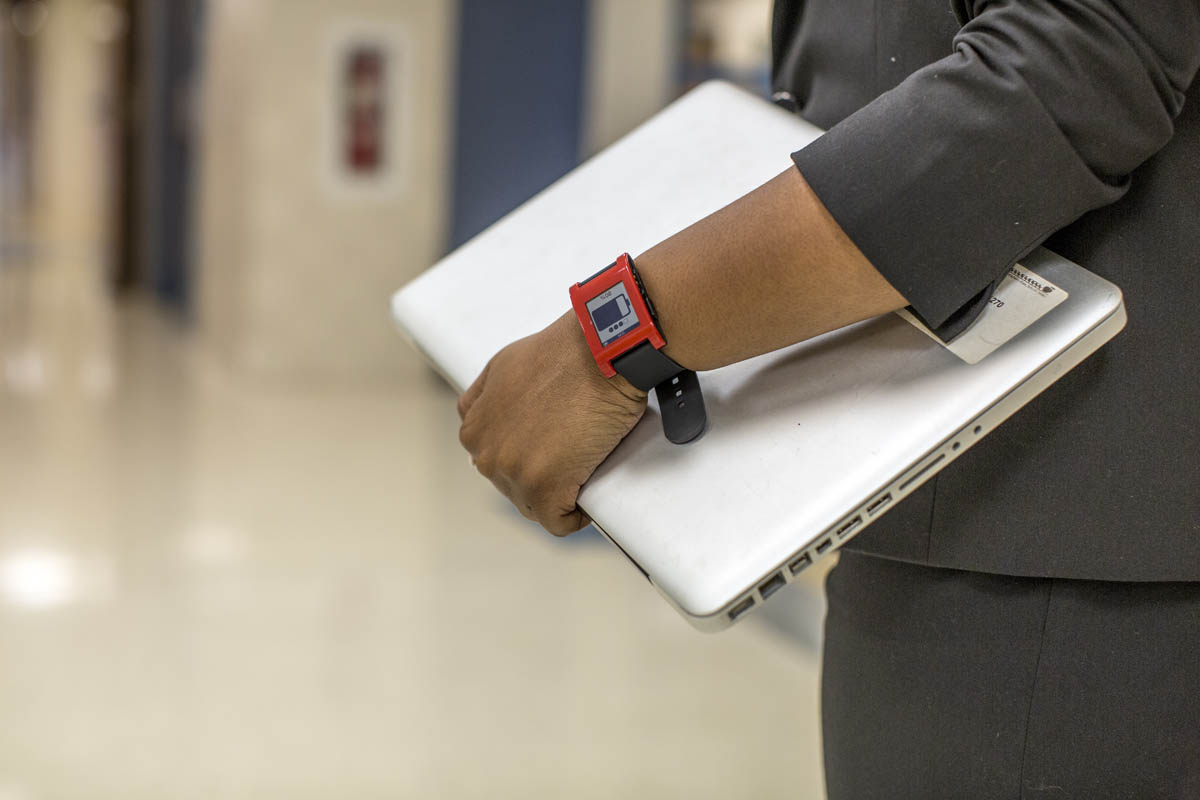A 'smart' way to track time

Lincoln Elementary School Principal Benita Draper is among 11 administrators in the Bethlehem Area School District taking part in an innovative Lehigh project that will track how principals and community school leaders use their time.
From her vantage point in a foyer of Lincoln Elementary School in Bethlehem, Principal Benita Draper can keep tabs on students as they head to classes or pass through the halls at different times throughout the school day. Last fall some Lehigh University faculty and graduate assistants kept tabs on her.
Draper was among 11 administrators in the Bethlehem Area School District who took part in an innovative project that aimed to better track how principals and community school coordinators use their time – and how that might correlate to student achievement and performance at their schools.
The pilot project, funded with a $22,582 Lehigh Faculty Innovation Grant, is being led by Craig Hochbein, assistant professor of educational leadership; Bridget V. Dever, assistant professor of school psychology; and George P. White, Iacocca professor of educational leadership.
The six principals, two assistant principals and three community school coordinators who participated in the project were set up with Pebble Smartwatches that allowed Lehigh to randomly text them throughout the day, for about month, and ask:
- How would you classify what you’re doing?
- With whom are you currently meeting? (Students, faculty, parents?)
- Briefly describe your current activity.
Participants had 15 minutes to respond via computer, but if the school leaders were dealing with a critical situation, that would have taken precedence, Hochbein says. Later the administrators were able to address why they weren’t able to respond, which would also provide insight into their schedules.
“We’re really trying to understand how they spend their days, and help them,” says Hochbein, who expected the project to produce a good data set that could lead to further research.
Earlier studies that examined the relationship between school outcomes and the way principals spend their day utilized logs or beepers to record time use, Hochbein says. Lehigh’s project team assessed whether the Smartwatch technology provided a better way to identify principals’ activities, since, for example, observer bias was eliminated. The technology also allowed the project team to send a unique—and silent—notification to administrators, so that Lehigh’s message hopefully wasn’t lost among the myriad of communications that school leaders typically receive. Future studies could incorporate more of the technology, such as tracking how many steps principals take in a day or how much time they spend inside or outside a school.
The data could prove significant in determining how principals should best use their time. While poverty is the greatest obstacle in student achievement, Hochbein says, principals and teachers have the next greatest impact on school outcomes since motivated students tend to perform better. He anticipated that the study would validate the belief that principals have challenging jobs, work long days and carry a lot of responsibility. Meanwhile, principals find more and more accountability measures being heaped on them.
But what activities correlate with success? And do principals and assistant principals in community schools do things differently than in traditional schools? Perhaps, Hochbein says, the study will show a need to alter a principal’s job, with the project team in a position to make recommendations based on the research.
To prepare for the pilot study, graduate assistant Linda Mayger set up the Smartwatches for Lincoln’s Draper and Community School Coordinator Arlene Gonzalez. Over the following week or so, Mayger and graduate assistant Emily Gallagher set up the watches for the rest of the participants so that they could receive the Lehigh texts and respond.
If Lehigh researchers had been tracking Draper on a recent Friday in early October, they would have likely noted her busy morning: staffing and scheduling issues, grade-level data meetings with teachers and reading specialists, morning announcement, a doughnuts-with-dad event.
“Every day is different…especially in an elementary school,” Gonzalez says.
Draper starts each day with a to-do list, but usually does not get a chance to complete it. Some days, she says, she is on the job well into the evening. She was interested not only in what the project would reveal about her daily schedule – “how much of my time is spent being an instructional leader or manager?” she asked – but also in what the study would reveal about time use differences between principals who, like her, work with community schools coordinators and those who do not.
“We believe that principals spend their time differently if they have community schools coordinators,” Mayger says.
The project team was hoping for a high response rate among participants, given the ease of responding to the texts and the novelty of the Smartwatches. (The response rate was remarkable: Participants responded to 84 percent of the 900 prompts.) Participants were tracked seven days a week, and beyond the length of the school day, since their jobs are difficult to turn off, even on weekends.
“We need to do a better job of capturing these out-of-school hours,” Hochbein says. “How many hours do we actually ask these people to do their jobs?”
Preliminary data showed principals were doing something school-related 85 percent of the time from 8 a.m. to 8 p.m. during the school week, and 25 percent of the time on weekends, when contacted, Hochbein said. The average response time was one minute and 28 seconds. The next phase of the project will a look at student outcomes at the schools, and whether there is any correlation with how principals spend their time.
Story by Mary Ellen Alu
Photos by Christa Neu
Posted on:



